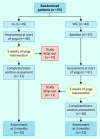Yoga for Patients with Early Breast Cancer and its Impact on Quality of Life - a Randomized Controlled Trial
- PMID: 24771916
- PMCID: PMC3864467
- DOI: 10.1055/s-0032-1328438
Yoga for Patients with Early Breast Cancer and its Impact on Quality of Life - a Randomized Controlled Trial
Abstract
The aim of this prospective, randomized, controlled trial was to investigate the impact of yoga on newly diagnosed patients with early breast cancer in the immediate postoperative phase. 93 women newly diagnosed with early breast cancer were randomized into an intervention group (IG) and a control group (waiting group, WG). The IG started yoga immediately after the operation. The WG started yoga 5 weeks after surgery. Both groups attended yoga classes twice weekly for 5 weeks. Quality of life (QoL) was evaluated using the EORTC QLQ-C30 and EORTC QLQ-BR23 questionnaires before the intervention, immediately after the operation and after 3 months. After 3 months the patients were asked whether yoga improved their physical activity and whether they wished to continue with yoga. The overall QoL (p = 0.002) and the functional status (p = 0.005) increased significantly in the IG, while physical symptoms decreased over time in both groups. 86 % of patients in the IG and only 59 % of patients in the WG (p = 0.04) confirmed a positive change in their physical activity through yoga. More women in the IG intended to continue with yoga (p = 0.03). Early initiation of yoga as a supportive treatment in cancer had a positive impact on QoL. Teaching yoga allowed patients to practice yoga by themselves, enhanced the patients' QoL and was found to improve physical activity.
Das Ziel dieser prospektiven randomisierten und kontrollierten Studie war es, den Einfluss von Yoga bei Brustkrebspatientinnen in der früh-postoperativen Phase zu untersuchen. 93 Frauen mit neu diagnostiziertem Mammakarzinom wurden in eine Interventionsgruppe (IG) und eine Kontrollgruppe (Wartegruppe, WG) randomisiert. Die IG begann sofort nach der Operation mit Yoga. Die WG startete 5 Wochen später. Für beide Gruppen erfolgten die Yogaübungen 2 × wöchentlich. Die Lebensqualität (QoL) der Patientinnen wurde mithilfe des EORTC QLQ-C30 und des EORTC QLQ-BR23 unmittelbar vor und nach der Intervention sowie nach 3 Monaten erfasst. Nach 3 Monaten wurden die Patientinnen zusätzlich zum Einfluss von Yoga auf ihre körperliche Aktivität sowie zu ihrem Wunsch, Yoga weiterhin zu praktizieren, befragt. Die globale QoL (p = 0,0002) und der funktionelle Status (p = 0,005) verbesserten sich in der IG signifikant, während die körperlichen Symptome im Verlauf in beiden Gruppen nachließen. 86 % der Patientinnen in der IG und nur 59 % der Patientinnen in der WG (p = 0,04) bestätigten einen positiven Einfluss des Yoga auf ihre körperliche Aktivität. Mehr Frauen der IG äußerten die Intention, Yoga weiterhin zu praktizieren (p = 0,03). Der frühe Beginn von Yogatraining als supportive Maßnahme in der Krebstherapie beeinflusst die QoL positiv. Yoga kann von den Frauen selbstständig praktiziert werden, was ihre Autonomie unterstützt und die körperliche Aktivität verbessert.
Keywords: breast cancer; oncological care; quality of life; yoga.
Conflict of interest statement
Figures
References
-
- Ferlay J, Autier P, Boniol M. et al.Estimates of the cancer incidence and mortality in Europe in 2006. Ann Oncol. 2007;18:581–592. - PubMed
-
- Gesellschaft epidemiologischer Krebsregister in Deutschland e.V. in Zusammenarbeit mit dem Robert Koch-Institut . Saarbrücken: Eigenverlag; 2006. Krebs in Deutschland. Häufigkeiten und Trends.
-
- Ries L AG, Eisner M P, Kosary C L. Bethesda: National Cancer Institute; 2005. SEER Cancer Statistics Review 1975 – 2002.
-
- Kümmel S, Kolberg H C, Lüftner D. et al.Mammakarzinom 2011 – Neue Aspekte. Geburtsh Frauenheilk. 2011;71:939–953.
-
- Ebrahim S. Clinical and public health perspectives and applications of health-related quality of life measurement. Soc Sci Med. 1995;41:1383–1394. - PubMed
LinkOut - more resources
Full Text Sources
Other Literature Sources




